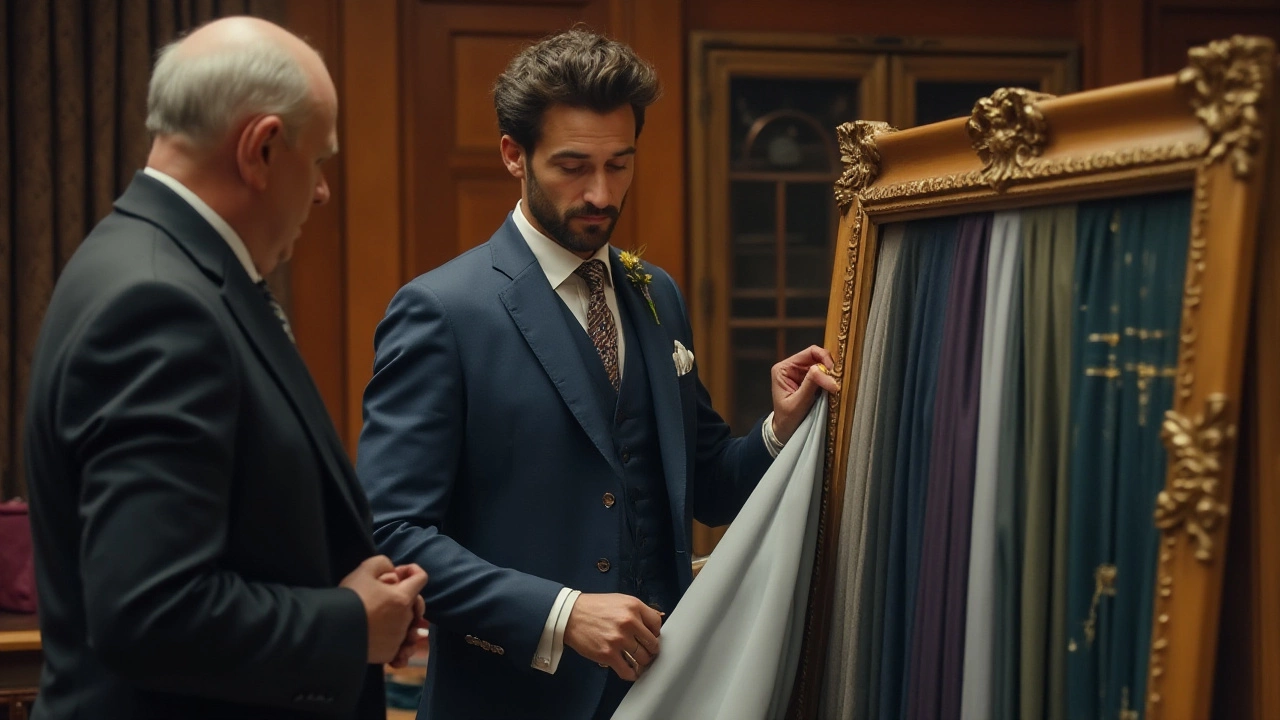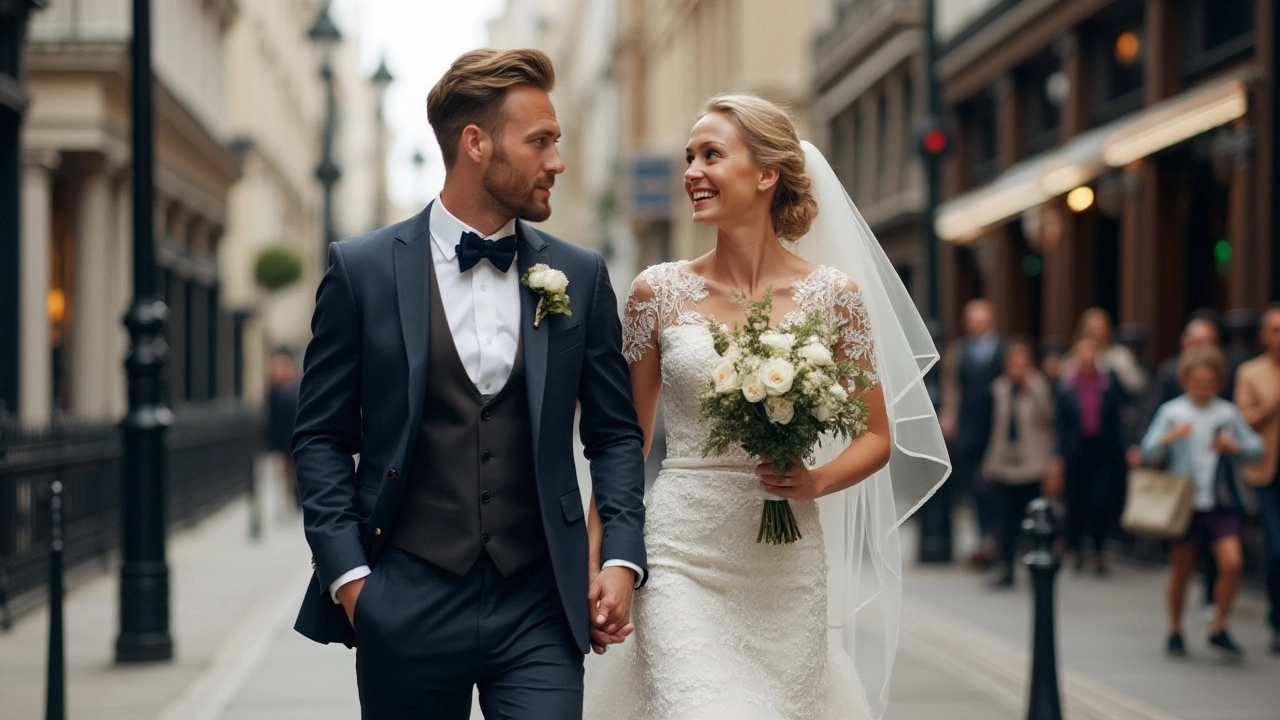When Should a Groom Get His Suit: A Comprehensive Guide
 Jan, 9 2025
Jan, 9 2025
When it comes to preparing for a wedding, timing is crucial, especially when it concerns the groom's suit. Gaining a comprehensive understanding of when to begin this vital process could save you from needless stress. It's about finding that perfect fit, in both time and style.
Starting the search early is key, as it provides ample opportunity to explore various styles and trends in men's fashion, ensuring that your chosen suit resonates with the wedding theme and your personal style. But how early is early? And what are the important milestones you should consider before the big day? This guide aims to walk you through each step to ensure a seamless experience.
- Understanding the Wedding Timeline
- Researching Styles and Trends
- Booking Your Fittings
- Allowing Room for Adjustments
- Last-Minute Checks and Storage Tips
Understanding the Wedding Timeline
Planning a wedding can be a whirlwind of decisions and deadlines, but when it comes to a groom's attire, understanding the timeline is crucial to avoid last-minute scrambles. An ideally planned wedding involves setting a firm timeline that makes room for all the details, including the purchase and fitting of the perfect groom suit. Generally, it's advisable for a groom to start looking for his suit about six to eight months in advance of the wedding date. This timeline allows ample opportunity for choosing styles, securing fittings, and accommodating any necessary alterations without the pressure of time.
One might wonder why this process requires such an extensive lead. In the fashion world, especially for bridal and groom attire, trends may shift, and availability can be unpredictable. This lead time also accounts for manufacturers' delivery schedules, which can be lengthy, especially for custom or tailored pieces. Starting early ensures that you have access to the latest in men's fashion, and allows for any adjustments needed if the initial fit isn't perfect. Getting caught out by delays can add stress and unwanted complications close to the wedding day.
Breaking it down further, here's a rough guideline of the steps involved. Initially, the groom should begin researching various styles that align with the overall wedding theme and personal preferences. The early months are ideal for browsing online collections, visiting stores, and even gathering inspiration from past weddings or magazines. Once you have a clear vision, it's wise to schedule initial suit fittings at least four months before the wedding. This period will ensure that your suit is not only ordered on time but also tailored to your precise measurements. "The suit should complement more than just the wedding colors; it should reflect the unique essence of the groom," suggests fashion expert Michael Korr, emphasizing the importance of personal style in wedding attire.
About two to three months before the wedding, another fitting should occur. This intermediate fitting acts as a checkpoint to ensure everything is progressing as planned. If your fitness regime or body shape has changed, this is the right time to address these changes with your tailor. The final fitting is typically held a few weeks before the wedding, allowing for any last-minute tweaks and ensuring that the suit perfectly flatters the groom's physique. Keeping track of each milestone in the timeline not only helps in reducing stress but also makes certain that your attire is nothing less than stellar for the day you say "I do."
Researching Styles and Trends
Diving into the world of groom suit styles and trends offers both excitement and a multitude of choices. The journey begins with understanding what resonates with modern aesthetics while ensuring the suit complements your personality and the wedding theme. Popular styles such as the classic tuxedo, the sharp three-piece, or the effortlessly chic single-breasted suit each bring something unique to the table. The color palette can range from traditional blacks and navies to contemporary shades like dusky pinks or emerald greens. In truth, there’s no wrong choice as long as it feels authentically you.
But how do these choices align with the current year? As we step into 2025, embracing individuality is key. Personalization in suits has been making waves, with grooms opting for bespoke tailoring to incorporate unique linings, personalized embroidery, or mix-and-match styles for a more casual and memorable look. A deeper understanding of fabrics is imperative: lightweight wool for versatility, velvet for a winter wedding, or breathable linen perfect for a summer affair. Trends might come and go, but comfort must never be compromised.
“The best approach is to start by identifying your specific style and fit preferences,” advises renowned Australian bespoke tailor, Anthony Smith. “Suits are more than just a piece of clothing; they’re an extension of your character. Spend some time observing runway showcases or celebrity weddings. Often, inspiration comes from seeing suits in action.”
Beyond personal taste, considering practicality is indispensable. Morning or evening, indoor or outdoor, the setting can significantly influence your choice. Choosing the right fit isn't solely about appearances, either; movement and ease can greatly affect how a groom carries himself on a day filled with excitement and emotion. Embrace trends that resonate with movements toward eco-friendly and sustainably made suits. A conscious choice makes a statement and reduces the environmental impact—a consideration growing more popular with today's couples.
Stay abreast of emerging trends through fashion magazines, blogs, and social media influencers specializing in men's fashion. Attending bridal shows or visiting stores to try suits can offer hands-on insights. These experiences bring valuable perspectives that online browsing can't provide. This phase should be free from pressure; allow yourself time to explore what's out there. Remember, the search for the perfect groom suit should be as enjoyable and memorable as the journey to the altar itself.

Booking Your Fittings
Once you have a clear idea of your preferred style and have shortlisted a few options, it’s time to think about booking your fittings. Timing your fittings right is essential to ensure that your wedding suit not only fits perfectly but also has that wow factor. It's recommended to schedule your first fitting about four to six months before the wedding day. This timeline allows sufficient time for multiple rounds of alterations, which are often necessary to bring a suit from a great fit to a perfect one. Considering how each body is unique, experienced tailors often anticipate one or two rounds of alterations.
When you arrive for your fitting, be prepared for a process that’s both detailed and intricate. Tailors will often begin by discussing the aspects of the suit that matter most to you – be it the drape of the jacket, the waistband's snugness, or the sleeves' length. Expect to try on various pieces, including the jacket, trousers, and sometimes the vest, to ensure each complements your physique. The more you communicate during this stage, the better the final result will be. Remember, attention to detail is key, so don't rush through this process.
It's also vital to bring along the exact shoes and shirt you plan to wear with the suit, as these can significantly impact how the suit fits. Bringing these items will help the tailor make the right adjustments, ensuring a cohesive look. Tailors can often make recommendations regarding any additional accessories that could enhance your ensemble, providing valuable insight that can elevate your style quotient on the big day.
According to renowned tailor Johnathan Green, "A well-fitted suit is a quintessential expression of style. It’s not just about the look but the confidence it imbues. Proper fittings are critical, because what you wear must reflect both your personality and the occasion's significance."
Remember to account for any weight changes when planning your fittings. Life is unpredictable, and stress often contributes to unexpected weight fluctuations. Communicate openly with your tailor if you suspect any changes. Flexibility in this regard ensures that adjustments can be made even closer to the wedding date if necessary. Tailors appreciate honesty; it enables them to do their best work.
For those who are particularly detail-oriented, or if you have opted for bespoke tailoring, consider keeping a small timeline for fittings and alterations to track progress. Each appointment should focus on specific aspects of the suit, moving from initial assessments to finer tweaks. This methodical approach can alleviate some of the stress associated with wedding preparations.
Allowing Room for Adjustments
The journey to acquiring the perfect groom suit is akin to crafting a masterpiece; it’s as much about the journey as it is about the destination. When it comes to tailoring, the phrase 'cutting it fine' is to be avoided at all costs, as meticulous adjustments are what transform a good suit into a great one. On average, it takes two to three fittings to get everything just right. This notion is echoed by Michael Kors, who wisely notes,
'It’s all about perfect fit and the details you can’t live without.'This wisdom speaks to the very heart of tailoring, where the suit is sculpted around your frame.
Giving yourself ample time for these adjustments is crucial—typically, starting the tailoring process at least three months before the wedding is recommended. This timeline accounts for adjustments that may be needed after initial fitting sessions. Whether it’s taking in the waist, hemming the trousers, or adjusting the sleeve length, each change requires precision that can only be achieved by experienced hands. In fact, data from a tailors' survey revealed that the most common last-minute alterations involve waist adjustments and sleeve fixings. To ensure harmony between your body shape and suit, allow your tailor the time needed to apply their expertise.
Adjustments often reveal themselves after a 'wear-test' where you spend some time wearing the suit, moving around, and sitting, providing a real-world feeling rather than just a static fitting. This practice helps identify any potential discomforts or fit issues. Be it the need for extra room in the shoulders or a tighter fit in the waist, such adjustments ensure that the suit feels like a second skin. As the big day approaches, it’s crucial to remain in communication with your tailor, ensuring that any additional changes can be managed gracefully.
Importantly, do not underestimate the value of having backup plan options, such as fabric patches that match your suit. In this way, if there’s a last-minute snag or an unexpected incident, quick fixes can be easily managed. Equipped with an eye for detail and the foresight to plan, achieving that dapper look you’ve always envisioned will indeed be possible on your wedding day. With these tips, you’ll glide into the day with the confidence that comes from knowing you’re impeccably suited for the occasion.

Last-Minute Checks and Storage Tips
As the wedding day approaches, making sure every detail is perfect becomes a priority, especially when it comes to the groom suit. Performing last-minute checks is crucial to prevent unexpected surprises. Start by inspecting the suit thoroughly. Each piece should be in perfect condition, free from any discrepancies like loose threads, missing buttons, or stains. Pay particular attention to the fit, as last-minute alterations might still be possible with a proficient tailor, granted there's a bit of time. Your suit should fit like a glove, offering both style and comfort, allowing you to focus on the celebration rather than any discomfort.
Storing the suit correctly is just as important as checking it. Breathable garment bags are a must-have as they help protect the fabric while allowing it to breathe, preventing moisture build-up that could damage the material. Keep the suit hanging in a spacious area, where it won’t be crushed by other clothes. It’s even worth considering investing in a sturdy, wooden hanger as these help maintain the shape better than plastic ones. To add an extra layer of protection, place cedar blocks in the closet or garment bag. Not only do these keep moths at bay, but they also lend the suit a pleasant, natural scent.
Checklist for the Big Day
Prepare a small checklist a few days before the event. This list should include ensuring that the shirt, tie, or bowtie is ready, along with coordinating shoes that have been polished to perfection. Accessories such as cufflinks, a pocket square, and a belt or suspenders should not be overlooked. Consider keeping a stain remover pen and a small sewing kit nearby; these can be lifesavers for unexpected minor accidents. Remember, feeling prepared instills confidence on the big day.
"Success is where preparation and opportunity meet." – Bobby Unser
There’s an opportunity to work some personal touches into the preparation. Perhaps a unique inner lining in the jacket that holds meaning, or initials monogrammed discreetly, adding that personal flair to your wedding ensemble. Such details might seem small but they contribute significantly to the overall experience, creating lasting memories. It’s worth noting that many a stylish groom has found himself in a last-minute scramble but with the right preparation, these situations can be avoided.